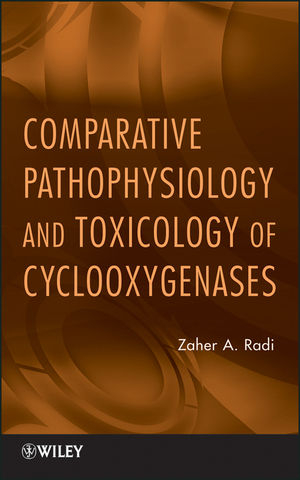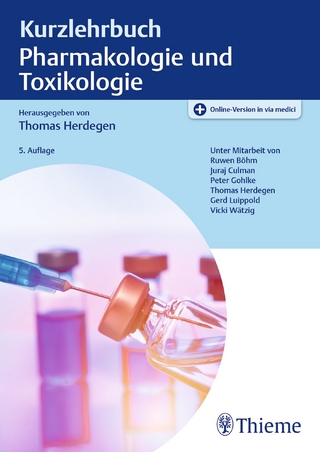
Comparative Pathophysiology and Toxicology of Cyclooxygenases
John Wiley & Sons Inc (Verlag)
978-0-470-57754-7 (ISBN)
The first thorough review of cyclooxygenase inhibitors, including their toxicity mechanisms and toxicopathological risks
Cyclooxygenases (COXs) are enzymes responsible for the formation of an important class of biological mediators called prostanoids. Prostanoids such as prostaglandins mediate inflammatory and anaphylactic reactions. For those suffering from inflammation and pain, the pharmacological inhibition of COXs, with non-steroidal anti-inflammatory drugs (NSAIDs), such as ibuprofen, can provide relief. Yet the use of NSAIDs can trigger toxicological effects as well, leading to potential health risks.
Comparative Pathophysiology and Toxicology of Cyclooxygenases provides a comprehensive overview of how COX inhibitors affect various bodily systems, specifically the toxicity mechanisms triggered when the COX enzyme is inhibited. The book provides an introduction to the discovery of cyclooxygenases, their use as therapeutic agents, as well as an historical perspective. Shedding light on the differences in expression, pathophysiology, and toxicology of COX inhibitors across species, the book offers a systematic examination of the effects and pathophysiology of COX inhibitors and their mechanisms of toxicity, beginning with the GI tract. Subsequent chapters cover:
The pathophysiology of COX inhibition on bone, tendon, and ligament healing
COX inhibitors and renal system pathophysiology and mechanisms of toxicity
The pathophysiologic role of COX inhibition in the ocular system
COX inhibition and the respiratory and cardiovascular systems
The book also sheds light on the latest research devoted to developing COX inhibitors with no adverse side-effects. The first book to offer a thorough comparative look at the toxicological effects of COX inhibitors throughout the body, this invaluable resource will help advance the research and development of safer and more effective COX drugs.
ZAHER A. RADI is a Research Fellow and Toxicologic Anatomic Pathologist in Drug Safety R&D at Pfizer Worldwide Research & Development. He has published over fifty-five research papers and review articles, in addition to book chapters and numerous abstracts and presentations.
PREFACE xi
INTRODUCTION: DISCOVERY OF CYCLOOXYGENASES AND HISTORICAL PERSPECTIVE 1
Aspirin 1
Prostaglandins 2
Cyclooxygenases 4
COX-2 Selective NSAIDs 7
References 8
CHAPTER 1 GASTROINTESTINAL TRACT 11
Introduction 11
Comparative COX-1 and COX-2 Expression in the GI Tract 13
Effects of ns-NSAIDs on the GI Tract 15
Effects of Arylpropionic Acid ns-NSAIDs on the GI Tract 17
Effects of Enolic Acid (Oxicam) ns-NSAIDs on the GI Tract 22
Effects of Acetic Acid Derivative ns-NSAIDs on the GI Tract 23
Effects of Aminonicotinic Acid Derivative ns-NSAIDs on the GI Tract 26
Effects of Pyrazolone Derivative ns-NSAIDs on the GI Tract 27
Effects of Salicylic Acid Derivative ns-NSAIDs on the GI Tract 28
Effects of Anthranilic Acid Derivative ns-NSAIDs on the GI Tract 30
Effects of COX-1 Inhibitors on the GI Tract 30
Effects of COX-2 s-NSAIDs on the GI Tract 31
Pathophysiology and Mechanisms of NSAID-Associated GI Toxicity 38
Role of Cyclooxygenase Potency 39
Species Differences in NSAID-Associated Susceptibility to GI Injury 39
GI Anatomical Differences 40
Enterohepatic Recirculation and NSAID Toxicity 41
Role of Xenobiotic Glucuronidation 42
Aging and Stress and NSAID GI Effects 43
Disruption of GI Physiological Mucosal Defense Mechanisms 44
GI Disequilibrium 45
Effects on Physiological GI Mucosal Cell Renewal Mechanisms After Mucosal Injury 46
Effects on Leukocyte Adhesion Molecules and Trafficking 49
Effects of GI Physiological Local pH, Gut Absorption, and Fasting 50
NSAID Topical Effect-Mediated Injury 51
Changes in GI Motility, Microcirculation, and Enterobacteria 52
Decreased Phosphatidylcholine Levels 53
Impaired Drug Metabolism 54
Role of Toll-like Receptor (TLR)-4/MyD88 and Enteric Bacteria 54
Role of Uncoupling of Mitochondrial Oxidative Phosphorylation 56
Role of Peroxisome Proliferator-Activated Receptor γ 56
Role of Mitogen-Activated Protein Kinases 57
NSAID GI Injury-Associated Risk Factors 57
Conclusions 57
References 58
CHAPTER 2 BONE–TENDON–LIGAMENT SYSTEM 72
Introduction 72
Comparative Physiological and Anatomical Aspects of the Skeleton 72
Role of Prostaglandins in Skeleton Metabolism 78
The Process of Bone Healing and Potential Role of Prostaglandins 85
Inflammatory Response 85
Bone Resorption 88
Bone Formation 90
COX-1 and COX-2 Expression in Bone, Tendon, and Ligament During Repair and in Pathological Conditions 91
Effects of ns-NSAIDs on Bone Healing 96
Effects of COX-2 s-NSAIDs on Bone Healing 103
Effects of ns-NSAIDs on Ligament and Tendon Healing 112
Effects of COX-2 s-NSAIDs on Ligament and Tendon Healing 113
Conclusions 114
References 115
CHAPTER 3 RENAL SYSTEM 127
Introduction 127
Comparative Physiological, Developmental, and Anatomical Aspects of the Renal System 128
Role of Prostaglandins in the Renal System 140
COX-1 and COX-2 Expression in the Kidney 149
Effects of ns-NSAIDs on the Kidney 154
Effects of COX-2 s-NSAIDs on the Kidney 162
Potential Mechanisms of NSAID Effects on the Renal System 165
Conclusions 166
References 167
CHAPTER 4 CARDIOVASCULAR SYSTEM 180
Introduction 180
Comparative Physiological and Anatomical Aspects of the Cardiovascular System 181
The Heart 181
Cardiovascular Blood Flow 183
Cardiac Conduction System and Blood Pressure 183
Heart Rate 186
Renin–Angiotensin–Aldosterone in the Cardiovascular System 187
Natriuretic Peptides in the Cardiovascular System 188
Cardiovascular Research and Animal Models 189
Cardiovascular Atherosclerosis 191
COX-1 and COX-2 Expression in the Cardiovascular System 192
Pathophysiological Role of Prostaglandins in the Cardiovascular System 196
Effects of NSAIDs on the Cardiovascular System 201
Effects of COX-1 and COX-2 Inhibition on Myocardial Ischemia, Infarction, and Thrombosis 201
Effects of COX-1 and COX-2 Inhibition on Coronary Blood Flow and Blood Pressure 211
Effects of COX-1 and COX-2 Inhibition on Atherogenesis 215
Conclusions 216
References 216
CHAPTER 5 OCULAR SYSTEM 228
Introduction 228
Comparative Physiological and Anatomical Aspects of the Ocular System 228
Role of Prostaglandins in the Ocular System 238
COX-1 Expression in the Eye Under Normal and Pathological Conditions 245
COX-2 Expression in the Eye Under Normal and Pathological Conditions 248
Effects of COX-2 s-NSAIDs in Ophthalmology 253
Effects ns-NSAIDs in Ophthalmology 256
Conclusions 259
References 259
CHAPTER 6 RESPIRATORY SYSTEM 270
Introduction 270
Comparative Physiological and Anatomical Aspects of the Respiratory System 270
Role of Prostaglandins in the Respiratory System 275
COX-1 Expression in the Respiratory System Under Normal and Pathological Conditions 283
COX-2 Expression in the Respiratory System Under Normal and Pathological Conditions 288
Effects of COX-2 s-NSAIDs on the Respiratory System 295
Effects of ns-NSAIDs on the Respiratory System 299
Conclusions 300
References 301
CHAPTER 7 CURRENT RESEARCH STRATEGIES FOR DESIGNING SAFER NSAIDs 309
Nitric Oxide–Releasing NSAIDs 309
Hydrogen Sulfide–Releasing NSAIDs 311
NSAIDs Associated with Zwitterionic Phospholipids 311
Chiral NSAIDs 313
Trefoil Peptides 314
Novel Mechanism of Action NSIADs 314
mPGES-1 Inhibitors 316
References 316
INDEX 321
| Erscheint lt. Verlag | 12.10.2012 |
|---|---|
| Verlagsort | New York |
| Sprache | englisch |
| Maße | 164 x 241 mm |
| Gewicht | 605 g |
| Themenwelt | Medizin / Pharmazie ► Medizinische Fachgebiete |
| Studium ► 2. Studienabschnitt (Klinik) ► Pharmakologie / Toxikologie | |
| Naturwissenschaften ► Chemie | |
| ISBN-10 | 0-470-57754-1 / 0470577541 |
| ISBN-13 | 978-0-470-57754-7 / 9780470577547 |
| Zustand | Neuware |
| Haben Sie eine Frage zum Produkt? |
aus dem Bereich


